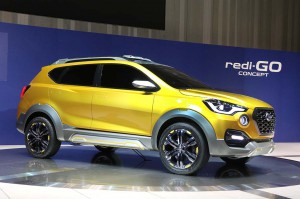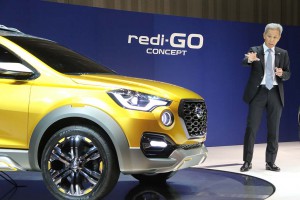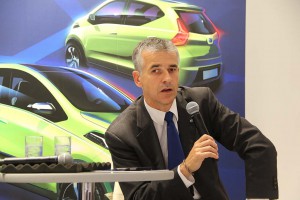With its tall roof, high seating position, rugged-looking skid plate and sunset-orange paint, the new Go-Cross looks like a stylish take on the crossover utility vehicles that have become increasingly popular in placed like the U.S., Europe and Japan.
But when it comes to market a couple years from now, it will take aim at a select group of emerging markets including India, Indonesia, South Africa and Russia. And it will likely carry a price tag of under US$10,000, a fraction of what a similar model might go for in established markets.
While officially a concept car, for now, the Go-Cross is all but certain to become one of the next models offered by Nissan Motor Co. through its recently revived Datsun division.
The brand was created in 1931 – though it was originally spelled Datson – to differentiate a line of small cars sold by the DAT Motorcar Co. of Japan, which eventually became part of what is known as Nissan today. The Datsun name was used for Nissan when it came to the U.S. but the automaker eventually decided to use one badge worldwide, beginning to phase out Datsun in 1986.
Talk of reviving the Datsun brand floated around for years, gaining momentum as Nissan CEO Carlos Ghosn began targeting key emerging markets, such as India. The comeback was announced in 2012 and the first new Datsun in decades went on sale in mid-2014.
The original plan was to target three promising markets: India, Russia and Indonesia, but South Africa was quickly added to the list. Datsun now builds a handful of products in three plants. But as the Go-Cross suggests, it has much bigger ambitions.
“The first mandate for us was to prove the brand…to prove it works,” said Datsun President Vincent Cobee, during a roundtable interview at Nissan headquarters in Yokohama, Japan.
(Nissan Teatro for Dayz concept is a car for people who don’t like cars. Click Here to learn why.)
After a year, it’s starting to look like Datsun is delivering. It has already sold more than 114,000 vehicles, a reasonably solid figure considering its minimal product line-up and the markets it has targeted.
That said, it faces a number of challenges. Cobee acknowledged that sales in India, one of the world’s fastest-growing automotive markets, has not met initial expectations. It will take time, he cautioned, to establish the brand and build the sort of word-of-mouth reputation that strongly influences sales in the country.
Russia has also been a challenge, but that’s no surprise, parent Nissan has also been losing ground in a market where the economy has been sent in a tailspin by foreign sanctions and low oil prices. Overall Russian car sales are down by half since hitting a record of nearly 3 million just a few years ago.
So far, Datsun has taken a market-by-market approach to growth. It designed the little Go model primarily for India, the large Go-Plus for Indonesia.
What they have in common is the concept of offering strong styling and a reasonable level of content, for a low price – in some markets starting at less than US$5,000. That said, “I don’t do cheap cars,” stressed Cobee. “People who are buying my cars are spending one to two years of disposable income.”
(Navigating Tokyo in an autonomous Autonomous Leaf. Click Here to come along for the ride.)
The Go-Cross could be a critical product if it gets the formal nod from Nissan management. That seems likely, however, and the crossover could reach market in a couple years. Sharing its basic platform with the Go-Plus, it would tap into the booming global demand for SUVs and CUVs.
And it could be part of an expansion plan Datsun is now considering. While it doesn’t have any interest in targeting established markets – even Eastern Europe is likely not to be added to its list – there are plenty of places to go, from Zambia to Kazakhstan.
The ultimate goal, said Cobee is to go after “the 70% of the world’s population that used to make up just 10% of the car market.”
That’s rapidly changing. Sales in established markets are “virtually flat,” Nissan CEO Carlos Ghosn noted earlier this week, and likely not to reach much more than 1% or 2% annual growth in the years ahead. On the other hand, worldwide automotive sales are expected to double from 2010 to 2020, to 100 million a year. India is nudging double-digit growth, and some other markets aren’t far behind. If Datsun’s strategy is right, it could be perfectly positioned to ride that wave.
(Renault-Nissan Alliance set to overcome latest crisis, promises CEO Ghosn. Click Here for the latest.)



